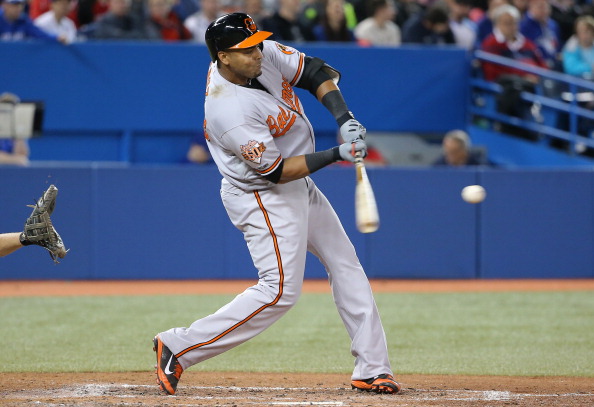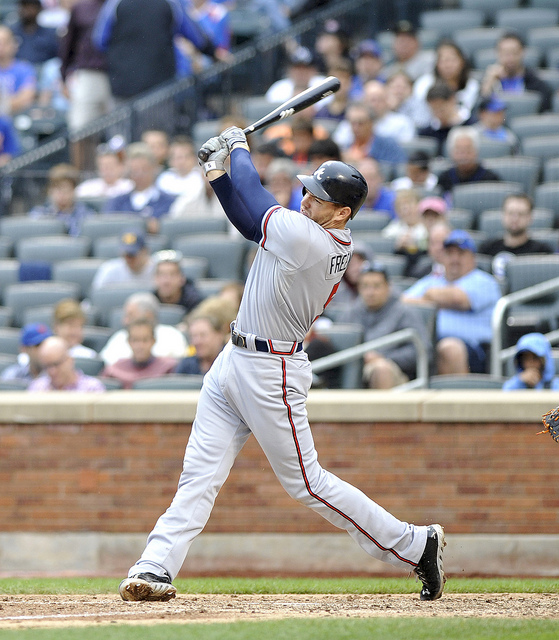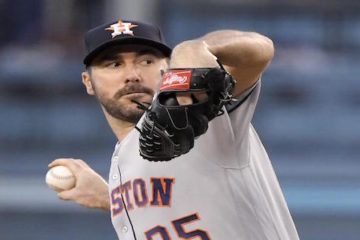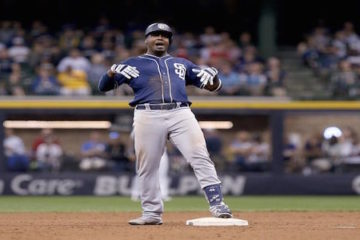First Basemen and Third Basemen: Like Him Less, Like Him More
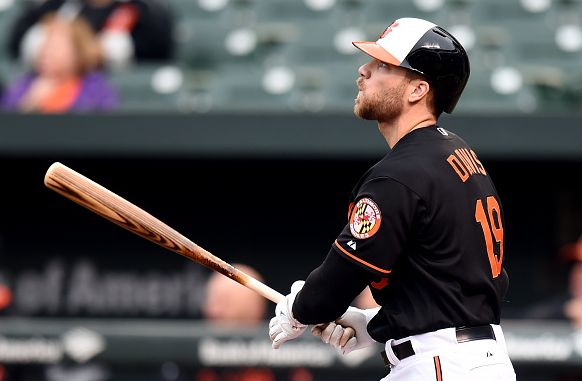
Power paired with punch outs finds itself in each section of this piece. That might seem hypocritical, but there’s an explanation forthcoming. A pair of veterans also find themselves in opposite portions of this article.
Like Him Less
Chris Davis – ECR: 1B-7, My Rank: 1B-13
The old saying goes, you can’t win a draft with your early picks but you can lose it. I’m a big fan of three-true-outcomes hitters like Chris Davis … at the right cost. Coming off of a down year in 2014, I was a fan of his draft price. Coming off of a season when he led the majors in homers with 47, I’m not a fan of the cost. So it goes. When the ball is leaving the yard at a high rate, Davis is a fantasy beast. In 2013 he hit 53 homers with a 29.6% HR/FB rate. Last season, he belted 47 homers with a 29.4% HR/FB rate. His 2014 season represents the dangers of Davis being just a tiny bit off, though, as his 22.6% HR/FB rate fueled only 26 homers. As my rank suggests, I don’t think he’ll be 2014 bad at all, but with strikeout rates hovering around 30% annually (31% in 2015), there’s serious batting average risk.
Doing a little back of the cocktail napkin math, if Davis repeated his fly ball total of 160 in 2015, per FanGraphs, and his HR/FB rate regressed to 25% (a mark that sits between his 2014 and 2015 mark and is in line with his 25.2% HR/FB rate in 2012), he’d have hit 40 homers. Assuming the seven non-homer fly balls resulted in outs, his average would have dropped about 12 points from .262 to .250 (after rounding up). And that batting average assumes he doesn’t suffer some bad luck on balls in play. The shift helped take some hits away in 2014 — as well as bad luck, in all likelihood — and he totaled a .242 BABIP. A BABIP that low is highly unlikely for a player with Davis’ hard-hit ball and line drive rates, but Steamer’s projection of a .303 BABIP for this year isn’t out of the question. Applying a .303 BABIP to Davis’ 2015 balls in play while also dropping the seven homers using the previously mentioned 25% HR/FB rate results in a .237 hitter. Of course, everything could go right for Davis again in 2016 as it did in 2013 and 2015, but I prefer a more stable skill-set inside the top 10 at first base. The position is loaded with offense, and while Davis’ upside is undeniable, it’s important to remember the downside, too. Again, I don’t hate Davis at all and would be happy to roster him in fantasy leagues. In fact, he’s probably the player I’m going to end up liking the most in the Like Him Less section of this series of articles.
David Wright – ECR: 3B-17, My Rank: 3B-22
David Wright is no longer a spring chicken, and staying healthy has been an issue for him. Last year, back issues limited him to just 38 games and 174 plate appearances in the regular season. Wright’s played more than 150 games just one time in the last five years, and lowering the bar to 130 games played adds just one more healthy-ish season to his resume in that time frame. Whether it be the result of maintenance days, a disabled list stint (or two) or a combination of both, it seems foolhardy to project more than 120-130 games played for Wright this season. The five homers he hit in 174 plate appearances last year are an unrealistic pace to expect over a larger total of games. He hit just eight homers in 586 plate appearances in 2014, after all. If he’s healthy enough to tally 500-ish plate appearances, 10-13 homers is a realistic projection. If his homers were coupled with his teens stolen base totals — or greater — through his peak years, that would be fine. However, Wright stole just two bases last year, and both steals came in his eight games played in April before hitting the shelf until August. There’s almost no incentive for the Mets to allow Wright to run much anymore, and even his eight steals in 2014 feel like an ambitious total to project in a healthy 2016 campaign. I’d be willing to hazard a guess he’s more likely to steal fewer than five bases than duplicate the eight from 2014.
The power and speed combination isn’t exciting, and he’s no longer a near-.300 hitter, either. Last year, he totaled a .289 batting average, but he needed a .351 BABIP that bests his career mark of .339 to get to that total. Wright continues to hit line drives at a high rate, kept his infield fly-ball rate under 7% (6.2% for his career) and rattled off a 33.6% hard-hit ball rate in 2015, so an above league average BABIP should be expected for Wright. That said, FanGraphs’ Depth Charts, Steamer and ZiPS peg him for a BABIP between .324-.326, not a repeat of his .351 BABIP. Wright’s more likely to hover a few ticks above or below a .270 average than flirt with .290 again. Wright’s strong walk rate will make him an OBP asset and a nice option out of the two-hole for the Mets, and that bodes well for his contributions in runs, but it’s still probably not enough to push him inside the top 20 at third base.
Like Him More
David Ortiz – ECR: 1B-15, My Rank: 1B-7 (Nine games at first base)
David Ortiz has aged incredibly well and he’s coming off of a season in which he ranked 12th in the majors with 37 homers. Unlike the previously highlighted player at first base — Chris Davis — he doesn’t carry a great deal of batting average risk with his top-shelf pop and hit .273 with just a 15.5% strikeout rate in 2015. Furthermore, he has upside in the batting average department beyond his ’15 mark if he can turn things back around against left-handed pitchers. Since 2013, Ortiz owns a .281 batting average. Big Papi has swatted at least 30 homers in three straight years with more than 100 RBI in each of those campaigns. Obviously RBI are largely a product of a lineup as a whole, but Boston’s lineup once again projects to provide Ortiz plenty of ducks on the pond whether he hits third or cleanup.
In 2015, only 20 players hit 30 or more homers and only 13 drove in 100 runs or more. There were only 11 players who did both, and just nine who did so while hitting .270 or better. Of the nine who hit all three benchmarks in 2015, five were eligible at first base. First base is loaded, and Ortiz is unlikely to match the other four first base eligible players in runs, and he’s a non-factor in stolen bases. However, Ortiz’s contributions in three categories and non-negligible runs scored upside is nothing to sneeze at and passes the sniff test for a top-10 first baseman. There’s no reason to believe Ortiz’s final season will be anything less than excellent.
Miguel Sano – ECR: 3B-12, My Rank 3B-5 (Nine games at third base)
I criticized Davis’ approach and the volatility that comes with a high strikeout rate, yet I ranked Miguel Sano well ahead of my peers at Fantasy Pros? Yup, that’s right. Third base simply isn’t as loaded as first base, and rolling the dice on volatility is an easier pill to swallow at the hot corner. Sano made asserted himself as a hell of an offensive player in his 335 plate appearances as a rookie last year. He swatted 18 homers and showcased plate discipline (15.8% walk rate) that belied his youth. Among hitters with a minimum of 300 plate appearances last season, Sano ranked tied for the 43rd lowest chase rate (25.8% O-Swing%). That didn’t prevent him from striking out quite often, though. Sano’s 35.5% strikeout rate would be major cause for concern is there weren’t reasons to believe in him shaving that number down significantly.
For starters, Sano’s already shown an ability to make adjustments when repeating a level. In 2013, Sano fanned in 29.3% of his plate appearances at the Double-A level. Last year (after losing the entire 2014 to recovering from Tommy John surgery), he struck out in just 23.8% of his plate appearances in his second tour of duty at the Double-A level. Coming off of a lost season, it’s rather remarkable he improved his strikeout rate by such a substantial amount. The majors is not Double-A, but having demonstrating the ability to make adjustments and improve while repeating a level is a feather in Sano’s cap. Also, Sano’s Z-Contact rate (76.3%) wasn’t wretched compared to the league average of 86.7% in 2015. The number negative number that stands out the most in the power hitter’s plate discipline profile is an ugly 33.8% O-Contact%. In fact, that was the lowest mark among hitters who compiled a minimum of 300 plate appearances. It was more than 10% lowest than the next lowest mark (45%) which was posted by fellow TTO machine Chris Carter. It’s almost unfathomable that Sano would continue to be that bad at making contact on pitches outside the strike zone. An improved strikeout rate should aid him in avoiding suffering a sizable dent to his .269 batting average that was inflated by a .396 BABIP.
Don’t regress his high BABIP to the league average, though. This guy makes some of the loudest contact in the game. Once again using the 300 plate appearance cut line, Sano’s 43.2% hard-hit ball rate trailed only Giancarlo Stanton’s mark (49.7%). Unsurprisingly, his exit velocity numbers are jaw-dropping as well. Among batters with a minimum of 100 at-bats tracked by Baseball Savant, his 99.80 mph average FB/LD exit velocity was also second only to Stanton’s mark (101.94 mph). Sano’s light-tower power was not exaggerated by scouts and prospect evaluators, and it ranks among the best in the game. This is a player on the verge of blossoming into a star.


